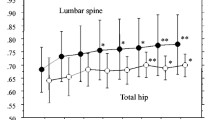Abstract
Alendronate has recently been approved for the prevention and treatment of postmenopausal osteoporosis, and its efficacy has been demonstrated in many Western countries. Our present study was performed to evaluate the effect of alendronate on bone mineral density (BMD) and its tolerability in Thais. Eighty postmenopausal women with osteoporosis participated in this study. After giving informed consent, the subjects were randomly allocated either 10 mg alendronate or placebo in a double-blind fashion. All patients received a supplement of 500 mg elemental calcium daily. BMD at the lumbar spine, femoral neck, and distal forearm was measured at baseline and 6 and 12 months after treatment. Biochemical markers of bone resorption were determined at baseline and 6 months after treatment. Baseline characteristics were similar in both alendronate- and placebo-treated groups. Ten subjects discontinued the study. Of 70 subjects, 32 received 10 mg alendronate daily and the remaining subjects received placebo. At 1 year, BMD in the alendronate-treated group had increased from baseline by 9.2%, 4.6%, and 3.1% at lumbar spine, femoral neck, and distal forearm, respectively. These percentages were greater than those in controls (4.1%, 0.6%, and 1.0%, respectively). Urinary N-terminal telopeptide (NTx)-I and serum C-terminal telopeptide (CTx)-I levels decreased in both groups after 6 months of treatment. However, more reduction was demonstrated in the alendronate-treated group (71.9% vs. 28.4%, P ≪ 0.01, and 84.7% vs. 33.1%, P ≪ 0.01, respectively). Compliance with treatment and drug tolerability were good in both alendronate and placebo groups. We concluded that treatment with alendronate 10 mg daily for Thai postmenopausal women with osteoporosis significantly increased BMD at all skeletal sites and reduced biochemical markers of bone resorption. It was well tolerated without any serious side effects.
Similar content being viewed by others
Author information
Authors and Affiliations
About this article
Cite this article
Chailurkit, Lo., Jongjaroenprasert, W., Rungbunnapun, S. et al. Effect of alendronate on bone mineral density and bone turnover in Thai postmenopausal osteoporosis. J Bone Miner Metab 21, 421–427 (2003). https://doi.org/10.1007/s00774-003-0438-2
Received:
Accepted:
Issue Date:
DOI: https://doi.org/10.1007/s00774-003-0438-2




